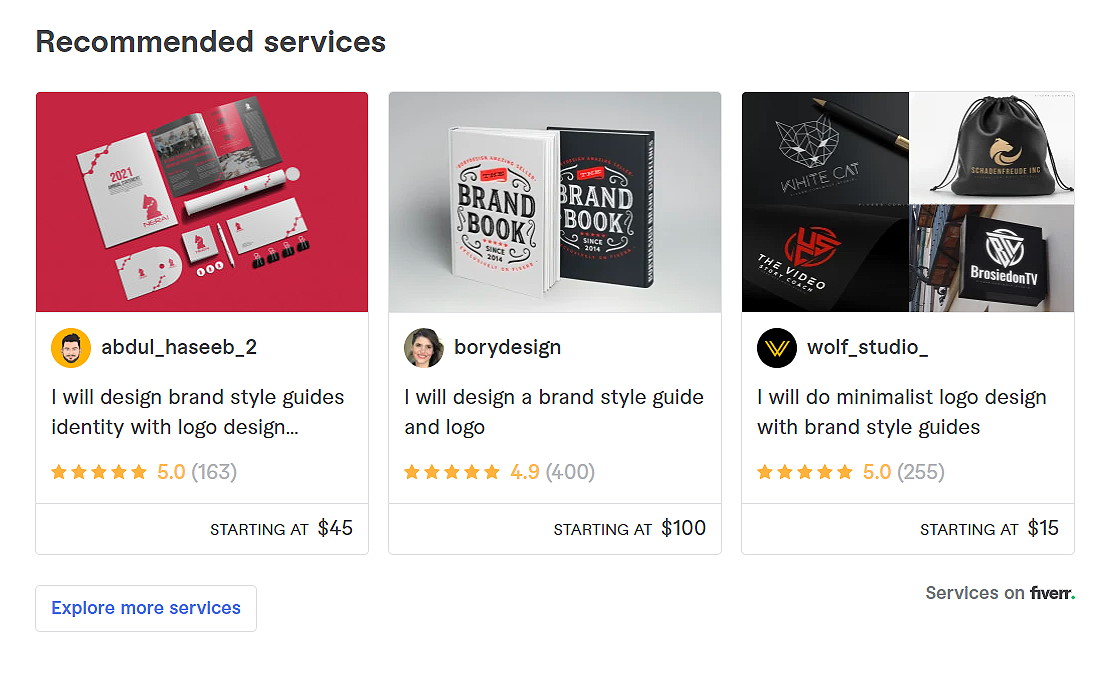Topics To Be Included In Brand Style Guide October USA? | Checkout Best Brand Style Guides on Fiverr 2023
Best Brand Style Guide On Fiverr | Upto 30% OFF Checkout NOW
A well-defined brand style guide serves as a comprehensive roadmap that ensures consistency across all brand touchpoints, from marketing materials to online platforms. So let us read more about the Topics To Be Included In Brand Style Guide October USA.
So Which Topics To Be Included In Brand Style Guide October USA?
In today’s fast-paced and competitive business landscape, establishing a strong and recognizable brand identity is crucial for success.
This Topics To Be Included In Brand Style Guide October USA article delves into the essential topics to be included in a brand style guide, helping businesses create a unified and memorable brand identity that resonates with their target audience.
Brand Identity Overview
So as per this Topics To Be Included In Brand Style Guide October USA article, Start your brand style guide by providing an overview of your brand’s identity, mission, and values.
This section should encapsulate what your brand stands for and what sets it apart from competitors. Include a brief history of the brand, its core values, and the emotions you aim to evoke through your visual elements.
Logo Usage Guidelines
Your logo is the cornerstone of your brand identity. Detail the variations of your logo, including color, size, and placement specifications.
So based on this Topics To Be Included In Brand Style Guide October USA article, Ensure that the logo maintains its integrity across various mediums, whether it’s print, digital, or merchandise. Address any restrictions on altering the logo, such as changing colors or proportions.
Color Palette and Typography
SO as guided in this Topics To Be Included In Brand Style Guide October USA article, Establish a consistent color palette that resonates with your brand’s personality and values. Specify primary and secondary colors, along with their Pantone, RGB, and CMYK values for accurate reproduction.
In addition, define typography guidelines for headings, subheadings, and body text to maintain a cohesive visual language across all materials.
Imagery and Photography Styles
Outline the types of imagery that align with your brand, such as photography, illustrations, or graphics. Provide examples of preferred image styles, whether they are vibrant and dynamic or minimalist and subdued.
So according to this Topics To Be Included In Brand Style Guide October USA article, Specify any filters, effects, or editing techniques to ensure a consistent visual identity across all media.
Voice and Tone Guidelines
So considering this Topics To Be Included In Brand Style Guide October USA article, Your brand’s voice and tone dictate how you communicate with your audience. Define the tone (e.g., friendly, professional, informal) and the vocabulary that should be used to convey your brand’s personality. Offer examples of how to adapt the tone for different platforms, from social media to formal documents.
Messaging and Taglines
Craft clear and concise messaging that encapsulates your brand’s value proposition. Include taglines, slogans, or mission statements that resonate with your target audience. Explain when and where these messaging elements should be used to reinforce brand consistency.
Iconography and Symbols
If your brand incorporates icons or symbols, provide guidelines for their usage. Specify when and how these elements should be employed to enhance visual storytelling and maintain a cohesive look and feel.
Digital and Print Guidelines
Different platforms demand different design considerations. Provide specifications for digital assets like social media banners, email templates, and website layouts.
Simultaneously, address print materials such as business cards, letterheads, and brochures, ensuring brand consistency across both digital and physical mediums.
Social Media and Online Presence
In today’s digital age, a strong online presence is paramount. Detail guidelines for profile images, cover photos, and post designs across various social media platforms. Consider the responsive design to ensure your brand remains consistent and recognizable on both desktop and mobile devices.
Collateral and Merchandise
Extend your brand’s reach by outlining guidelines for collateral and merchandise design. Whether it’s branded apparel, promotional items, or packaging materials, provide specifications to maintain the integrity of your visual identity.
Brand Applications
Showcase real-world examples of how your brand style guide has been applied successfully. Highlight case studies or before-and-after visuals that demonstrate how adherence to the guidelines has strengthened brand recognition and consistency.
Advantages Of Brand Style Guide
A brand style guide is a crucial tool for maintaining consistency and coherence in your brand’s visual and communication elements. While I can provide general advantages of a brand style guide, I don’t have real-time information about specific events or developments in October 2023.
However, I can outline some of the benefits of having a brand style guide in the USA or any other location:
Consistency: A brand style guide ensures that your brand’s visual elements, such as logos, colors, fonts, and imagery, remain consistent across all marketing materials, websites, social media profiles, and other touchpoints. This consistency helps build recognition and trust among your audience.
Professionalism: A well-defined brand style guide gives your brand a professional and polished appearance. It shows that your brand pays attention to detail and is committed to delivering a high-quality experience to customers.
Clarity: A style guide provides clear guidelines on how to use your brand’s visual elements, ensuring that everyone involved in creating marketing materials or content understands how to apply them correctly. This reduces confusion and minimizes the risk of using inconsistent or incorrect branding.
Efficiency: With a brand style guide in place, designers and content creators can work more efficiently, as they have a clear reference to follow. This speeds up the process of creating new materials and reduces the need for constant back-and-forth communication.
Brand Identity: A style guide helps solidify your brand’s identity and messaging. It defines the tone, voice, and messaging guidelines that reflect your brand’s values and resonate with your target audience.
Flexibility: While consistency is important, a brand style guide also allows for flexibility within established parameters. It provides a framework that allows creative expression while maintaining the core brand identity.
Coherent Customer Experience: A consistent brand style extends beyond visual elements. It also guides the overall customer experience, ensuring that every interaction with your brand feels coherent and aligned.
Asset Management: A style guide often includes guidelines for using and organizing digital assets, making it easier to manage and share resources among team members.
Collaboration: A style guide fosters collaboration among different teams and departments by providing a common reference point. This is especially important for larger organizations or those with multiple stakeholders.
Brand Equity: Over time, a strong and consistent brand presence builds brand equity, making your brand more valuable and memorable in the minds of consumers.
Remember that a brand style guide should be regularly reviewed and updated to stay relevant and adaptable to changing trends and market dynamics. If you’re planning to create or update your brand style guide, consider working with experienced designers and marketers to ensure its effectiveness.
FAQ About Topics To Be Included In Brand Style Guide
1. What is a Brand Style Guide?
A Brand Style Guide is a set of guidelines that defines the visual and verbal elements of a brand’s identity, ensuring consistent representation across all touchpoints.
2. Why is a Brand Style Guide important?
A Brand Style Guide maintains brand consistency, helps communicate the brand’s values, enhances recognition, and builds a strong brand image.
3. What are the key components of a Brand Style Guide?
The key components typically include:
- Logo usage and variations
- Color palette and usage
- Typography and fonts
- Imagery and photography style
- Iconography and illustrations
- Voice and tone for written content
- Brand messaging and positioning
4. How do I use the Brand Style Guide?
The guide serves as a reference when creating any branded material, ensuring that the brand’s visual and verbal elements are used consistently and accurately.
5. Can I customize the Brand Style Guide for different platforms?
Yes, you can provide specific guidelines for different platforms, such as social media, print materials, and websites, to adapt the brand’s identity appropriately.
6. What should I include in the Logo section?
Include the primary logo, logo variations (e.g., horizontal, vertical), clear space requirements, and rules for logo usage on different backgrounds.
7. How do I establish a Color Palette?
Detail the primary and secondary color palettes, including hex or RGB codes, and specify which colors are for backgrounds, text, accents, etc.
8. What should be covered in the Typography section?
List the approved fonts for headings, body text, and other content, along with font sizes, line heights, and any specific formatting guidelines.
9. What about Imagery and Photography style?
Define the types of images that align with the brand, such as mood, subjects, filters, and composition guidelines.
10. How do I address Iconography and Illustrations?
Provide guidelines for creating and using icons and illustrations consistent with the brand’s visual identity.
11. What is Voice and Tone?
Explain the brand’s personality and how it should be reflected in written content. Define appropriate language, style, and tone for different communication contexts.
12. How do I convey Brand Messaging and Positioning?
Outline the core brand messages, mission statement, and positioning in the market to guide consistent communication.
13. Can I include Examples and Non-Examples?
Yes, providing visual examples of correct and incorrect usage helps clarify expectations.
14. How often should the Brand Style Guide be updated?
Regularly review and update the guide to accommodate changes in the brand’s identity or market trends.
15. Who should have access to the Brand Style Guide?
Make the guide accessible to all relevant team members, designers, content creators, and external partners working on brand-related materials.
A well-crafted Brand Style Guide serves as a critical tool for maintaining a consistent and strong brand identity across various channels and materials.
Conclusion About Topics To Be Included In Brand Style Guide October USA
A meticulously crafted brand style guide is a powerful tool that unifies your brand’s visual and verbal identity.
By providing comprehensive instructions for logo usage, color palette, typography, imagery, voice, and more, businesses can ensure a consistent and memorable brand presence across all touchpoints.
A well-executed brand style guide not only fosters recognition but also establishes an emotional connection with your target audience, ultimately leading to increased brand loyalty and market success. So this concludes the article about Topics To Be Included In Brand Style Guide.

